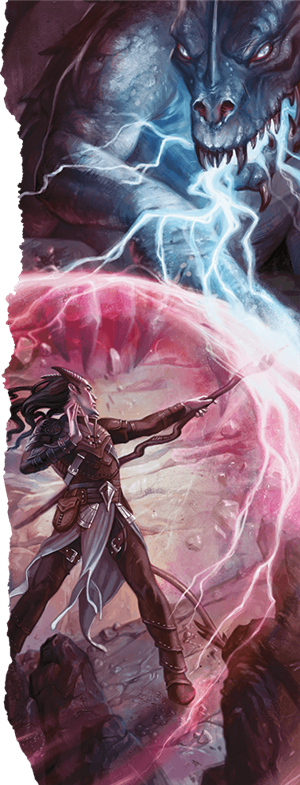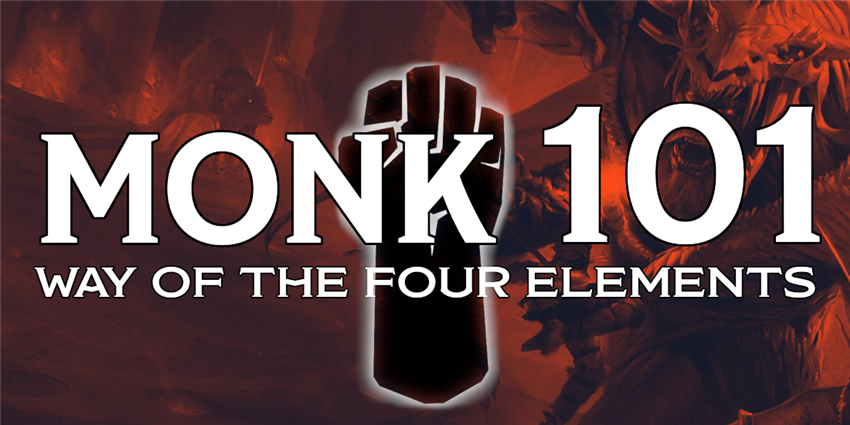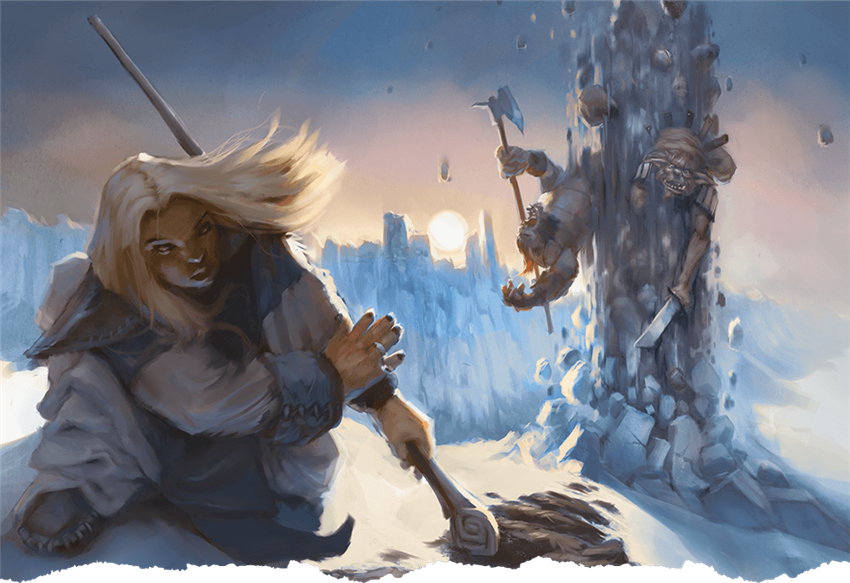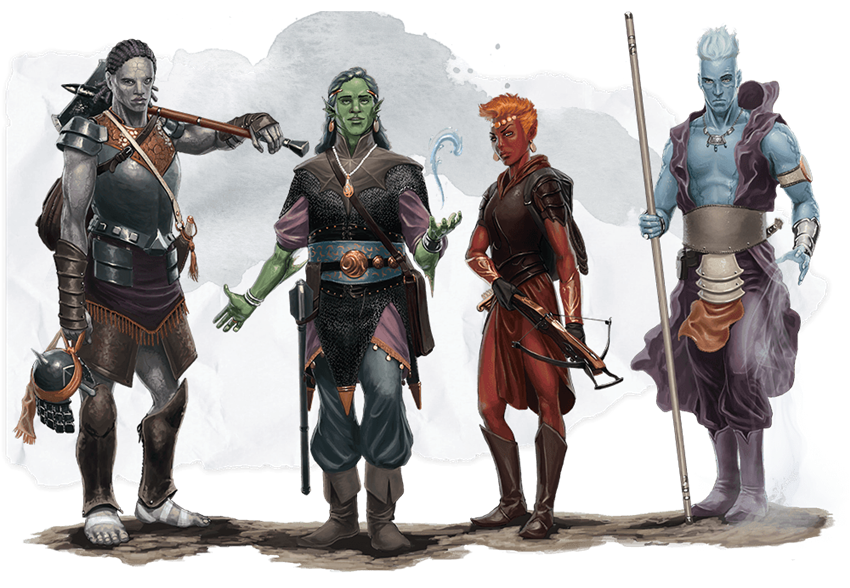 Class is back in session. This week, we don monastic garb and meditate upon the mysteries of the world and all the realms beyond it. Through rigorous perfection of both body and soul, monks of the Way of the Four Elements gain the power to wield the primal elements of nature itself for both attack and defense. A monk versed in these mystic arts lets that power comingle with their very soul, channeling the mystic energy known as ki out of their own bodies in order to will the elements into being from nothingness.
Class is back in session. This week, we don monastic garb and meditate upon the mysteries of the world and all the realms beyond it. Through rigorous perfection of both body and soul, monks of the Way of the Four Elements gain the power to wield the primal elements of nature itself for both attack and defense. A monk versed in these mystic arts lets that power comingle with their very soul, channeling the mystic energy known as ki out of their own bodies in order to will the elements into being from nothingness.
We’ve completed our first full rotation of the twelve classes, and exhausted all the content that the Basic Rules have to offer—as far as classes go, that is. This next wave of the Class 101 series will appraise every subclass within the Player’s Handbook and break down each subclass’s strengths, weaknesses, thematic elements, and everything else a player would want to know before playing that subclass. Because of this, you will need to own the Player’s Handbook (or purchase the subclass a la carte on the Marketplace) in order to make full use of this series.
Check out other articles in the Monk 101 series, like our broad overview in Monk 101: A Beginner’s Guide to Mystical Combat, and Monk 101: Way of the Open Hand. If you’re interested in playing other classes, check out the entire Class 101 series.
Story of the Way of the Four Elements
“To think of the elements as separate forces is a blindfold. You must unlearn this partial truth to see the world for what it is.” A wizened sage sat cross-legged atop a raised platform, before a room filled with eager pupils. All were dressed in colorful robes of red, white, blue, and green that declared to the all that they were united as monks of their monastery. “Those of you who have been taught to feel the currents of the air likely feel that the energy of the solid earth is its opposite. This is false. Earth is firm and slow to change, but it is just another expression of universal energy—of the ki which permeates all worldly things.”
The pupils sat in rapt attention, but the master saw that many of them seemed lost. As he continued to speak, their attention began to drift. The master sighed, cracked his knuckles, and stood. “You may not understand now, but hold this truth in your mind as you practice. Knowledge, paired with experience, will draw the blindfold from your eyes. Now—enter your neutral stance. Let us begin!”
Way of the Four Elements Features
A monk’s monastic tradition typically grants them additional ways to use their ki points to create mystical effects. The Way of the Four Elements is one of the most magical of all the monk subclasses, using ki to produce air, earth, fire, and water from their body’s own energy. While most other monk subclasses grant distinct features at 3rd, 6th, 11th, and 17th level, the Way of the Four Elements has only one feature: Disciple of the Elements, which is gained at 3rd level. You gain increasing levels of elemental power from this feature at 5th, 6th, 11th, and 17 level.
You can read all of the Way of the Four Elements features in the Player’s Handbook. In short, the Disciple of the Elements “meta-class feature” grants you access to Elemental Disciplines of increasing power, which you can spend increasingly large amounts of ki to activate.

Benefits of the Way of the Four Elements
Some of the most interesting features of the Way of Four Elements monk subclass are its elemental disciplines which don’t replicate existing spells. Elemental Attunement, Fangs of the Fire Snake, Fist of Unbroken Air, Shape of the Flowing River, and Water Whip are all exciting, flavorful, and unique features that make this subclass stand out from other “one-third caster” subclasses, like Eldritch Knight and Arcane Trickster.
Drawbacks of the Way of the Four Elements
Regrettably, the Way of the Four Elements is not only one of the weakest monk subclasses, it’s one of the weakest subclasses in the Player’s Handbook. While its flavor is strong and evocative, the Way of the Four Elements offers limiting and inflexible combat options, and next to no features that can be used effectively while exploring or while interacting with other creatures. The subclass gains spells at a “one-third caster” rate, equivalent to an Eldritch Knight fighter or an Arcane Trickster rogue. This progression works fine for Eldritch Knights and Arcane Tricksters, but the Way of the Four Elements monk suffers from two major problems: it has an extremely limited spell selection, and it has to split its limited ki points between primary class features and its elemental subclass features.
Compare the level of flexibility a Way of Four Elements monk has to an Eldritch Knight fighter. A 17th-level Eldritch Knight can learn up to 13 spells, chosen from all evocation and abjuration spells on the wizard spell list from 1st to 4th level—a total of 34 spells in the Player’s Handbook alone. On the other hand, the Way of Four Elements can learn elemental disciplines, which replicate the effects of a single spell (though a few have unique effects). A 17th-level monk can learn four disciplines from a pool of seventeen. That’s less than one-third the spells known from a spell list that’s half the size of the Eldritch Knight’s.
This, combined with the fact that the Way of Four Elements monk has to choose between casting spells and using iconic monk features like Flurry of Blows and Patient Defense, makes it a regrettably lackluster option compared to other subclasses that mix martial prowess and magical skill.
If your Dungeon Master is willing to use house rules, consider using the following house rules to buff the Way of the Four Elements subclass:
- Reduce the ki cost of all Elemental Disciplines by 2 (to a minimum of 1). This cost reduction is applied after you spend additional ki to raise the spell’s level. For example, the Fist of Four Thunders discipline lets you cast thunderwave for 2 ki. This cost is reduced to 1. Casting the spell at 2nd level increases the ki cost to 3, but it still only costs 1 ki point after the cost reduction of 2 points.
- At 3rd level, you learn the Elemental Attunement discipline as normal, and two other disciplines of your choice (instead of just one).
- You learn two new disciplines at 6th, 11th, and 17th level (instead of just one), and can replace any discipline you know with another one that you meet the level requirements to learn when you gain a level in this class.
- You can also learn two cantrips of your choice from the following list: acid splash, fire bolt, mold earth, produce flame, ray of frost, shocking grasp. When you gain a level in this class, you can replace one of these cantrips with another instead of replacing an elemental discipline with another. (If you have other sources, such as Xanathar’s Guide to Everything or Elemental Evil Player’s Companion, you can choose other cantrips from those sources that deal acid, cold, fire, or lightning damage, or have an otherwise elemental theme, with your DM’s permission.)

Suggested Build
If you’re playing a monk from 1st level, you should choose a race that improves either Dexterity, Constitution, or Wisdom—ideally two of the three. Dexterity will make your attacks stronger and more accurate, Constitution will grant you more hit points, which will help you last longer on the front lines, and Wisdom will increase your Armor Class and make it harder for foes to resist your martial abilities.
Wood elves gain a bonus to both Dexterity and Wisdom, making them agile and cunning martial artists. Likewise, stout halflings gain a bonus to both Dexterity and Constitution, making them nimble but durable skirmishers. And, as always, humans gain either a small bonus to all ability scores, or can gain a feat by taking the “variant human” race, making them more flexible in their builds. If you're playing Princes of the Apocalypse or using the Elemental Evil Player's Companion, you can play a genasi, which has a strong elemental theme built in. Water genasi gain a bonus to Wisdom, and air genasi gain a bonus to Dexterity, making them both solid choices if you want to play a monk.
As usual, your character’s background is up to you. You can make your character more unique by choosing unusual backgrounds like Sage, representing a former student of the wizardly arts that has taken up a monastic lifestyle and found a new use for their knowledge of the elements. Or, you could create a more archetypal character by choosing a background like Hermit, representing someone who has lived in solitary contemplation of the multiverse’s secrets for years.
Choose EQUIPMENT instead of GOLD at the end of character creation. Choose a shortsword or another simple melee weapon of your choice that doesn't have the heavy or two-handed property. Thanks to your Martial Arts feature, you can add your Dexterity modifier to attack and damage rolls with most simple weapons, rather than your Strength modifier.
You won’t choose your Way of the Four Elements subclass until you reach 3rd level as a monk, so use this time as a 1st- and 2nd-level monk to figure out if the Way of the Four Elements is really the right path for you. Are you enjoying the fantasy of being a master of all four elements? Do you feel like you need more martial artistry in your game, and would prefer to be a monk of the Way of the Open Hand? Or are you learning that stealth is more your speed, and that you would rather skulk about in the Way of the Shadows?
Elemental Disciplines
With your options so limited, choosing your preferred elemental disciplines can be challenging. Starting at 3rd level, you only know two disciplines: the cantrip-like Elemental Attunement, and one other of your choice. Your choices at 3rd level are:
- Fangs of the Fire Snake (unique)
- Fist of Unbroken Air (unique)
- Rush of the Gale Spirits (replicates gust of wind)
- Shape of the Flowing River (unique)
- Sweeping Cinder Strike (replicates burning hands)
- Water Whip (unique)
With six options to choose from, making a decision can be a challenge. Fangs of the Fire Snake is one of the superior offensive choices, while Shape of the Flowing River can be useful while exploring in areas of wilderness with plenty of water or ice. Water Whip is an excellent voice as well, because of its high single-target damage and ability to manipulate another creature’s position on the battlefield.
As you level up, you gain more options to choose from, but the ability to spend additional ki points to cause low-ranking disciplines to scale in damage shouldn’t be underestimated. Fangs of the Fire Snake is especially useful, since its bonus damage and reach apply to all attacks you make in a single turn.

Feats
At 4th level, you get to gain either an Ability Score Increase or a feat. Choosing an Ability Score Increase lets you increase one ability score by +2 (such as increasing your Wisdom score from 16 to 18) or increase two ability scores by +1 (like increasing your Wisdom from 15 to 16 and your Constitution score from 13 to 14). Increasing your ability scores makes you better at a wide variety of things; for instance, increasing your Wisdom score makes it harder for enemies to resist your spells, makes it easier for you to hit with your spells, and also makes you better at making Wisdom checks.
Feats, on the other hand, give you a special ability that could be more helpful in a specific circumstance, as opposed to the broad improvement that an Ability Score Increase could give you. Wisdom is your most important ability score, since it governs your spellcasting abilities. Once you’ve increased your Wisdom score to 20 (its maximum value), or even just to 18 (a pretty good value), you may want to choose a feat. You can choose any feat you want to support your character concept, but there are some feats that may be more useful to your character than others.
Generally, a monk is better off maxing out their Dexterity and Wisdom scores than taking feats. However, if you do want to get a few more special abilities, consider the following feats:
Elemental Adept (Fire). Though this feat doesn’t work from a strict interpretation of the rules, a permissive DM may allow you to apply this feat to your Elemental Disciplines, like Fangs of the Fire Snake. If so, it can be quite powerful. If not, avoid this feat.
Mage Slayer. If you find yourself facing a lot of magic-users in your campaign, your multitude of attacks and high mobility make you a top-notch mage slayer.
Mobile. Monks are already highly mobile thanks to the Unarmored Movement feature, but being able to make attacks and still avoid opportunity attacks while dashing through the battlefield is hard to pass up.
Resilient (Wisdom). If you’re playing a low-level campaign, this feat is incredible. Gaining proficiency in Wisdom saving throws and increasing your own Wisdom score by one is great. If your campaign goes to 14th level or higher, though, this feat is mostly dead weight, since you gain proficiency in all saving throws once you gain the Diamond Soul feature at 14th level.
Skulker. While you won’t be as stealthy as a Way of Shadows monk, this feat will help you launch blistering surprise attacks.
If you want more advice for building a monk, check out Monk 101. Have you ever played a Way of the Four Elements monk? What advice would you give to players that want to play this subclass?
 James Haeck is the lead writer for D&D Beyond, the co-author of Waterdeep: Dragon Heist, Baldur's Gate: Descent into Avernus, and the Critical Role Tal'Dorei Campaign Setting, a member of the Guild Adepts, and a freelance writer for Wizards of the Coast, the D&D Adventurers League, and other RPG companies. He lives in Seattle, Washington with his fiancée Hannah and their animal companions Mei and Marzipan. You can find him wasting time on Twitter at @jamesjhaeck.
James Haeck is the lead writer for D&D Beyond, the co-author of Waterdeep: Dragon Heist, Baldur's Gate: Descent into Avernus, and the Critical Role Tal'Dorei Campaign Setting, a member of the Guild Adepts, and a freelance writer for Wizards of the Coast, the D&D Adventurers League, and other RPG companies. He lives in Seattle, Washington with his fiancée Hannah and their animal companions Mei and Marzipan. You can find him wasting time on Twitter at @jamesjhaeck.








-
View User Profile
-
Send Message
Posted Nov 9, 2019This has to be the subclass that every Avatar fan wanted. Sadly... It just isn't great.
I appreciate that the article gets straight to the point and calls out the rather glaring problems with the subclass features.
It seems to me that the designer(s) who wrote this subclass were erring on the side of caution.
The unique abilities are fun and would have made a nice base for the subclass, maybe by expanding with a sorcerer-like limited list or elemental tagged spells and powered by spell slots. Something akin to the Eldritch Knight would have been great.
Anyway, there are a myriad of possible fixes, but at the end of the day, nothing is going to have the much-desired "official" stamp on it until it sees print.
-
View User Profile
-
Send Message
Posted Nov 10, 2019I think everybody knows that variant human works for every class ever by now, instezd why not mention the Hill Dwarf? +2 con and +1 wis are nice ways to shore up your defenses and you already enhance the spellcasting.
1 extra hp per lvl is also nice. They make great monks.
-
View User Profile
-
Send Message
Posted Nov 10, 2019Excellent article! I really like the options you presented to buff Elemental Monk a little. I'm kind of surprised it was not addressed in the last UA playtest.
-
View User Profile
-
Send Message
Posted Nov 10, 2019Fangs of the fire snake has the most damage
-
View User Profile
-
Send Message
Posted Nov 10, 2019So if I understood correctly, the cost of using the discipline at its lowest level would be reduced but when when you want to raise its level, the cost is whatever it would normally be?
Since in this case you said casting thunderwave would be 1 ki but at second level its 3.
Sorry but the phrasing is really confusing
-
View User Profile
-
Send Message
Posted Nov 10, 2019Thanks! I appreciate this, and I'm happy to hear it!
-
View User Profile
-
Send Message
Posted Nov 10, 2019Well, a proper spear, no it's not - you *might* be picturing a Javelin when you think of "spear", which were shorter and lighter, and mainly meant for throwing.
Spears of all origins, generally, were at least 7-9 feet long, or longer (!!!) and not meant for throwing.
There's several kinds of spears, particularly in Europe, but we're talking Monk and martial arts, so we'll focus on the Chinese "qiang", or spear, which is one of the 4 Chinese "king of weapons" - alongside with the staff, sword, and sabre. The main difference between the staff and spear was length, and the metal weapon head at the end. This changed the balance and thus fighting style of the weapon, but it could be similarly to a staff in some ways.
It's worth noting that while spears were quite prevalent in martial military forces around the world, no martial military force ever used staves.
For an interesting comparison google "wushu staff vs spear 1974".
-
View User Profile
-
Send Message
Posted Nov 10, 2019It kind of is. The latest Unearthed Arcana on Class Feature Variants does not make any changes to any subclasses. But it does make changes to class features in ways which benefit some subclasses more than others. I draw your attention to this feature enhancement for the monk:
While this does benefit all monks, it clearly benefits monks who consistently take non-Attack actions costing ki (i.e. WotFE) more than monks who use their action to Attack every round. Using the Attack action does not cost ki and allows Flurry of Blows as a bonus action, whereas spending ki to cast a spell does not.
But, unfortunately this doesn't go far enough. You can see my previous post on this thread for how I have rebalanced my own reflavoured versions of WotFE.
Come to think of it, I suspect the Class Feature Variants UA will very much exasperate the other problem with WotFE, which is the lack of spell options. Now you will be incentivised to pick spells which are compatible with making a free unarmed strike immediately afterwards, which realistically is only three of them (burning hands, cone of cold, Water Whip). Spells which push the target away don't work, and AoE spells which might require you to be inside the range if you are adjacent to the target aren't great either.
-
View User Profile
-
Send Message
Posted Nov 11, 2019If you really want to play a character that has an elemental bender feel to it; may I suggest druid.
-
View User Profile
-
Send Message
Posted Nov 11, 2019People REEEEEEALLY wanna play a fire/earth/air/water bender from avatar though.
-
View User Profile
-
Send Message
Posted Nov 12, 2019I've been very interested in the concept of this class, but the mechanics and options just seemed frustratingly lacking when compared to the other monk subclasses. The first thing I noticed was that if I wanted to play a monk which thematically emphasized one of the four elements, there weren't even a full complement of options for each of the elements at each tier of disciplines! The second thing I noticed was that the one great spellcasting advantage the class had, which was the ability to ignore material components, only really gave any benefit from Stoneskin. If your DM is enforcing the rule about components "ammo count," then sure, this class circumvents that. Meh. Third, the ki point cost is prohibitive, as you mentioned, but then also there is a written limitation rule to how much ki can be used to empower a discipline! While it's understandable that the designers wouldn't want early users of Burning Hands to be able to empower the spell greater than a spell caster of similar level, it cheapens very quickly as you gain levels, and still can't enhance to a point where other casters might use it. Because the ki resource is already a small pool, I think that factor enforces the spending amount just fine, if I wanted to burn all my ki in one all-or-nothing blast, however, that's not really an option, and that's disappointing. Lastly, more than a fair number of the disciplines have concentration durations, and you may not, at higher levels, even be able to see the usage of your lesser disciplines happen while using a higher discipline, and when you think about it, NO other subtype class feature interferes with the usage of a lesser class feature, unless it allows for a much larger choice of spell options.
These factors soured the class for me severely, so in addition to the fixes you've mentioned, I have tinkered with a few more already that may be beneficial options for you to discuss when discussing this class with your DM: Firstly, discuss spell options with your DM for each tier of disciplines under these guidelines- a 3rd level discipline can cast a 1st level spell, a 6th level discipline can cast a 2nd level spell, an 11th level discipline can cast a 3rd level spell, and a 17th level discipline can cast a 4th level spell. In some cases, your DM may allow you to fudge effects or spell levels a bit if you're willing to compromise other areas of utility in the spell, like gaining Freedom of Movement at 17th level but you are always the only target of the spell. Look! A playable capstone for the water element! Secondly, monks don't cast spells with finger waggling or draconic language, but with kiai shouts and kata movements, so any attempt to determine what school or type of spell a WoFE monk uses, such as with Spellcraft, are at disadvantage. This addition to their spellcasting is thematic and makes them unique, in addition to their ability to eschew materials. Thirdly, if you're NOT going to reduce the ki costs by 2 points, a better approach might be to simply ignore the ki-point spending limit. At high levels particularly, this feels right for the monk in terms of scaling ability. Lastly, adding a completely new ability at 11th level seemed necessary. I made mine as such- "Discipline Focus," when a discipline you use causes you to cast a spell which uses your concentration, you may now use one additional discipline which requires concentration. If you lose concentration on either spell, however, you lose the effects of both spells.
These extras made the class work much better for me, but it is obvious that this class needs the extra work to function at an acceptable level, and that's disappointing. Hopefully, a revision will be published in the UA soon!
-
View User Profile
-
Send Message
Posted Nov 12, 2019James, I really enjoy this remix and rebalance of the Way of Four Elements Monk. How would you change Fangs of the Fire Snake? Below I have presented two possibilities:
1) Flame Always On: When you use the Attack action on your turn, you can
spend 1 ki point tocause tendrils of flame to stretch out from your fists and feet. Your reach with your unarmed strikes increases by 10 feet for that action, as well as the rest of the turn. A hit with such an attack deals fire damage instead of bludgeoning damage, and if you spend 1 ki point when the attack hits, it also deals an extra 1d10 fire damage.2) Burning Hotter: When you use the Attack action on your turn, you can spend 1 ki point to cause tendrils of flame to stretch out from your fists and feet. Your reach with your unarmed strikes increases by 10 feet for that action, as well as the rest of the turn. A hit with such an attack deals fire damage instead of bludgeoning damage, and if you spend 1 ki point when the attack hits, it also deals an extra 1d10 fire damage, and an additional 1d10 for every ki point spent after that. The initial extra damage is increased by 1d10 at 5th level (2d10), and 11th level (3d10).
Either of these seem like they would work, or both of them could. Changing damage to fire is not a huge boost, and increasing the bang for your buck at levels 5 and 11 work with your suggestion of reducing ki costs by 2.
-
View User Profile
-
Send Message
Posted Nov 14, 2019Spears are underrated. :)
-
View User Profile
-
Send Message
Posted Nov 15, 2019I like most of this, with a couple of caveats:
-Also give them the four "control elements" cantrips (control flames, gust, mold earth, and shape water) at 3rd level.
-I would also let them trigger their bonus action unarmed strike and their flurry of blows features whenever they cast a cantrip.
-Allow them to add their dexterity/wisdom modifier (one or the other) to the damage of their cantrips.
Otherwise, leave it as suggested, and I really like it. As an initial proponent for the WoFE Monk and having played on in the past, I like these suggestions.
-
View User Profile
-
Send Message
Posted Nov 20, 2019Fang of the Fire Snake doesn't actually grant any bonus damage, unless you spend one ki point for every attack hit, not attack action. This means if you already have multy attack and use flurry of blows to attack 4 times, you must spend 4KI in addition to the one KI you spent for activation.
This means you can do extra 4d10 fire damage and via spending a total of 6 KI (1 flutty of blows, 1 activating fangs and 4 for the 4d10). You quite literally burn your KI for extra damage.
This is quite a good way to deal burst damage or potentially end a fight. Since you regain KI via short rest, it's a valuable asset to have.
The most useless ability you can take is actually eternal mountain defense. Just one lvl later you can spend your KI for major invisibility and dmg resistance that doesn't need concentration either.
-
View User Profile
-
Send Message
Posted Nov 21, 2019So i've been play a Monk of the 4 elements for a few sessions now, and my DM agreed to some of these changes. He allowed me to have cantrips and such. but how do I add spells to my character sheet?!
-
View User Profile
-
Send Message
Posted Nov 21, 2019The only way to manually add spells to your character on dndbeyond is to create your own homebrew feat which grants the spell, and give your character that feat.
An alternative option would be to create a homebrew version of WotFE which grants the extra spells, etc.
I checked to see if James had already implemented a homebrew of his version of WotFE, but he has not (his list of homebrew is empty). Perhaps that would be a good idea, James, if you are so inclined? (Not sure if he will read this.)
If you're paying a subscription to dndbeyond, you could instead use a different rebalanced WotFE subclass homebrew such as Way of the Four Elements: Remastered (a dndbeyond implementation of the reddit community's creation), or Way of the Avatar (disclosure: I made this).
-
View User Profile
-
Send Message
Posted Nov 22, 2019I'm hoping that we have not seen the last "CLASS FEATURE VARIANTS" UA. I am hoping for a future UA or publish material that touches the Way of for Elements Monk, Berserker Barbarian, Circle of the Land Druid, and of course the Beast Master Ranger.
-
View User Profile
-
Send Message
Posted Dec 22, 2019Avatar the Last Airbender anyone?
My favourite character is Zuko, and the movie sucks.
-
View User Profile
-
Send Message
Posted Dec 25, 2019Mine is Toph and The Turf Wars comics suck as well.